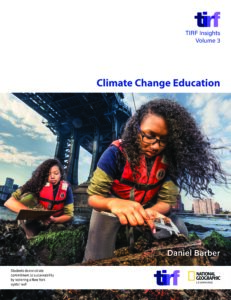Confronting Climate Change Education in ELT
Our world faces a number of challenges, and for many people, the most serious global issue is climate change, driven by the unsustainable use of the planet’s resources. But what does climate change have to do with English language teaching (ELT)?
At first glance, ELT might have little to do with environmental concerns. However, there are convincing reasons for ELT professionals to integrate sustainability into their teaching.![]()

Context: As our world is globally interconnected, many national and international education frameworks underscore the need for young people to become global citizens who take action. Pioneering educators in the field of sustainable development are leading the way in preparing young people to become the global citizens of the future.
Climate Change Education, or CCE, is the education sector’s response to the growing global concern for global warming. Sustainability is steadily becoming a focus of education in science syllabi, through student-based action, and as part of national curricula.
Implications: ELT instructors can play a key role in helping students develop language skills to participate in the climate change debate. Preparing learners to be a part of this ongoing conversation and to act with informed awareness is the very basis of education. Bringing climate change discussions into the ELT classroom will help students develop their voices for sustainability discussions outside of class.
What’s Next: The science of global warming is clear. As climate change awareness increases globally, we can expect to see a much greater focus on climate action in all areas of life, including English language education.
Read the Report: In this report from TIRF and National Geographic Learning (NGL), author Daniel Barber details how stakeholders in ELT are confronting issues involved in CCE. This paper is available in Arabic, Chinese (Simplified), English, and Spanish. Complete the form at the following link to download the paper:
About the “TIRF Insights” Series: The “TIRF Insights” Series profiles recent research in the field of English Language Teaching (ELT) in a practical and accessible format. Our publications are written for parents, teachers, school leaders, and all student advocates who want to review recent educational trends in a nonacademic way. TIRF is pleased to be working with NGL on this important endeavor.
Calls to Action: To promote further exploration and discussion for you and your colleagues on the issues raised in the TIRF Insights: Climate Change Education paper, here are some questions to guide a conversation around the topic of CCE.
- What role does climate change currently play in our students’ lives? How can we support students in learning more in a supportive atmosphere?
- What are the most relevant and impactful environmental issues that affect the learners’ local area and home country? How can we raise awareness of these issues and the part our leaners might play in tackling them?
- Which cultural factors arise when discussing climate change in our classrooms? Is there more we can do to support one another to handle these cultural sensitivities?
- What misgivings do we have regarding the adoption of CCE? Lack of training? Uncertainty around content that could be seen as political? Our own climate anxiety? What support could be helpful in overcoming these obstacles?
- What climate education projects would our students and our school like to take part in? What actions might benefit students, parents, the school, and the local community.

